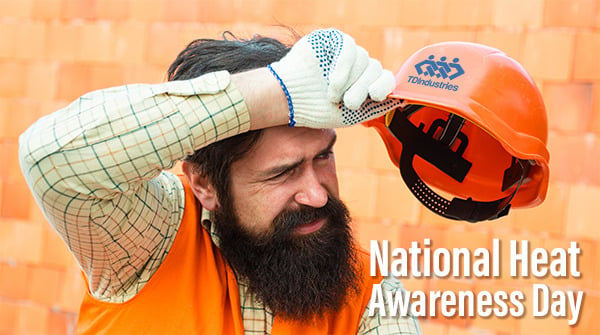
In the Southwest where TDIndustries works, checking the weather for dangerous heat and humidity forecasts are already a part of our daily routines. This year we observe National Heat Safety Awareness Day on May 28 or #NoFryDay. Yet understanding how to prevent heat-related illness and recognizing the key signs of heat exhaustion or stress are vital to our work site operations year-round.
"High heat is a significant amplifier for the likelihood of serious safety events," says TD Director of Safety Jamie Dabbs. "TD takes this hazard seriously. We focus safety meetings, policies and controls to better protect our Partners (employees) when temperatures soar."
Key Tips to Protect Yourself
The main factors affecting your body’s ability to stay cool during extremely hot weather include the following, according to the U.S. Centers for Disease Control and Prevention (CDC).
High humidity: Sweat doesn’t evaporate as quickly in high humidity, keeping your body from releasing heat as fast as it may need to.
Personal health challenges: Age, obesity, fever, dehydration, heart disease, poor circulation, prescription medications and even sunburn can all affect a person’s ability to maintain proper body temperature in very hot weather.
Strenuous activity: When the sun is hottest, physical exertion can add up quickly. Pace activities to allow time for recovery or schedule for early morning or late evening.
The U.S. Occupational Safety and Health Administration (OSHA) offers the following guidelines to protect yourself and others from heat illness at work.
Drink cool water — Even if you’re not thirsty, drink at least one cup of water every 20 minutes.
Avoid caffeine and alcohol — Some beverages, even iced tea, can be dehydrating.
Take rest breaks — Take enough time to recover from the heat given the temperature, humidity and conditions at your work site.
Find shade — Take designated breaks in a shady or cool location with air circulation if possible.
Dress for the heat — Wear a hat and light-colored, loose-fitting and breathable clothing if possible, taking other safety guidelines, including PPE requirements, into account.
Watch out for each other — Monitor yourself and others for signs of heat illness (see signs of heat exhaustion and heat stroke below). Verbally check on others frequently.
-1.jpg?width=760&name=TD_Heat_Stroke_Graphic-1024x536%20(1)-1.jpg)
Act Quickly on Serious Symptoms
If you notice abnormal actions or unclear thinking, slurred speech, seizures or loss of consciousness, call 911 immediately.
For other signs of heat stress, take these actions:
- Provide water or an electrolyte beverage to drink
- Remove unnecessary or restrictive clothing
- Move to a cooler area out of high-activity areas
- Cool with water, ice or a fan
- Don’t leave the person alone
- Seek medical care if needed
More from the Blog
How Modular Construction Benefits the Healthcare Industry
In December, CoStar published an article about construction backlog being at a three-year high. One of...
7 Key Reasons to Explore Modular Construction
Dynamic economic conditions, and explosive growth in data center and semiconductor manufacturing and...
What's Driving Modular Data Center Growth?
It’s that time of year when the 2023 research, market data and trends are published, providing hope and...
Subscribe to our blog
Please provide your email address to subscribe!
